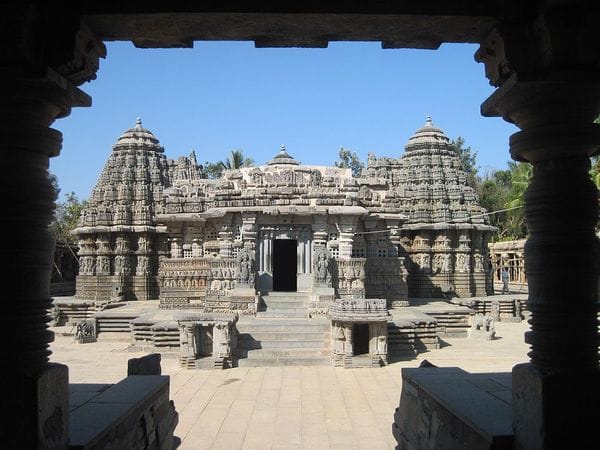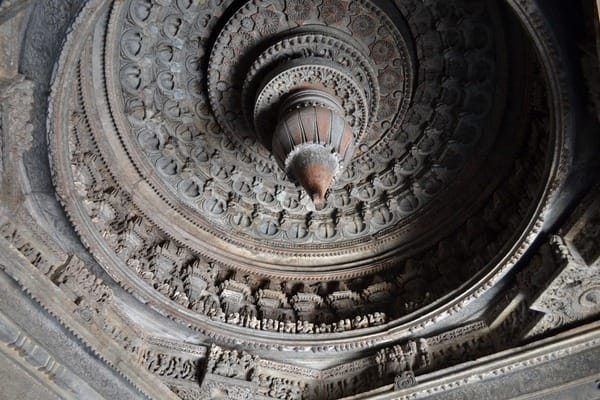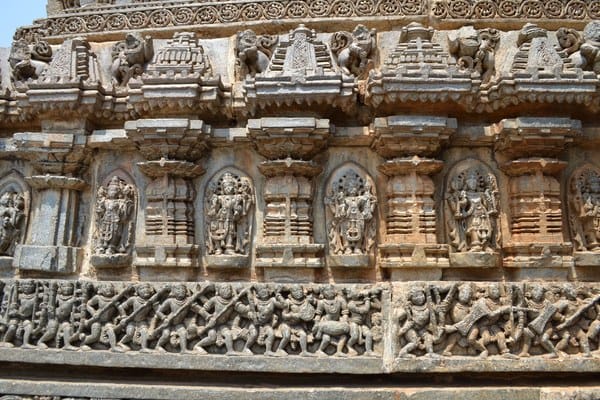
View of the Somanathapura temple from the porch entrance. Pic: Wikimedia Commons
The temple at Somanathapura took 58 years to build with 500 sculptors ceaselessly working on it. A true work of art, the Gods come alive in the stones of Somanathapura. The stone figurines speak to you, be it is the ornately carved temple ceilings, the intricately carved pillars or the heavily sculpted star shaped Trikuta style temple of Somanathapura. Somanathapura as the name suggests, is not a Shiva temple; it is a famous Hoysala styled Keshava temple.
A brief history
The temple was constructed in 1268 AD by commander of the Hoysala army, Somanatha, under the Hoysala king Narasimha III. The temple boasts of three idols – Keshava, Krishna and Janardhana, and is one of the many fascinating temples constructed by Hoysalas in Karnataka. The temple is made of soap stone, a malleable stone to work with and, was sculpted by various sculptors, the most famous among them being Mallithamma, who is said to have sculpted a majority of the carvings found in the temple.
Somanathapura is a Trikuta style star-shaped temple and has been built on an elevated platform. The original idol of Keshava was demolished by Mughal invaders, and since then the temple has ceased hosting religious ceremonies and functions. The temple has an image of Keshava brought in by the Archaeological Survey of India (ASI). This is flanked by Krishna and Janardhana on its left and right respectively. The intricately carved door of the temple was also restored by ASI in 1958.
The temple architecture
At the entrance of the temple, lies a stone slab with details about the temple, its festivals and grants donated from 1269 to 1550 AD in hale (old) Kannada inscriptions. Inside the temple, you can find decorative ceilings with patterns of banana flowers, lotus buds etc. The temple has a square shaped navaranga (congregation hall) which served as a dance floor to the devadasis of yesteryear. At the right, there is the statue of Janardhana with four shoulders. If you observe closely, you will find that his chest styled in the form of cow’s face.
The intricately carved ceiling of the temple. Pic: Usha Hariprasad
The ventilation ducts around the temple are dual shaped – stars from the inside and squares on the outside. On the outer wall you can find carvings of rows of elephants signifying strength, above it rows of horses for speed and finally, gods and goddesses in different poses. Some notable figures here are Dhanvantri, the god of medicine, Vishnu in his various avatars, Durga slaying the demon Mahishasura and the king of gods, Indra – all sharing a space on the outer walls. There are also various scenes from Ramayana and Mahabharata depicted on the walls.
Look closely and you will be astonished to see intricate details on the sculptures such as finger rings, bracelets, even finger nails look exquisite. The sculptors have made the best use of the corner walls, by efficiently using the space to carve out various figures like two elephants with one head. As was the common practice during the reign of the Hoysalas, the names of the sculptors, like Mallithamma, Balayya and Bhamayya, are engraved on the walls besides their work.
The outer walls of the temple. Pic: Usha Hariprasad
The temple is on a raised base of 87×83 feet and is surrounded by 64 cells which earlier seated demi-gods. These have now been shifted to a museum by ASI. The outside of the temple has a tall lamp tower. In the past, lamps were lit at the top of the tower, to signal the surrounding villages and inform them that religious ceremonies were being performed at the temple.
How to get there?
Somanathapura is 140 kilometres away from Bangalore and it takes around three to four hours to get there. If you are going by car, drive along the Mysore road up to Mandya. Turn off at the Bannur road, and drive for another seven kilometres to reach Somanathapura. If you are driving on Kanakapura road, you need to take the deviation to Bannur road at Malavalli.
If you plan to travel by bus, you can board one towards Mysore and then catch another to T Narasipura which is around 14 kilometres from Somanathapura. From here, there are ample buses, auto and taxis that will take you to the temple. Alternatively, you can board a bus to Mandya, and then catch a KSRTC bus towards Bannur, and from there to Somanathapura.
Food and Accommodation
There are no good hotels at Somanathapura. You could check out hotels on Bangalore-Mysore highway or at T Narasipura or Mysore. If you are looking to spend the night, the nearest lodging facility is available at Mysore.
Additional Tips
-
Hire a guide to get detailed information about the temple history and its intricate carvings. You require a minimum of two hours to soak up the history of this place.
-
It is better to carry your own food and water, as there are very few eateries near the temple.
-
You could combine the temple visit with a trip to Talakad and Shivanasamudra waterfalls as well.

